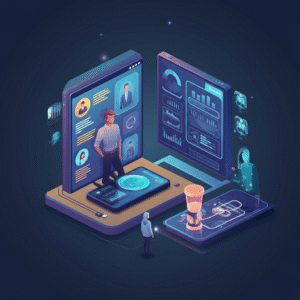
Introduction
The landscape of business is shifting. Artificial intelligence, once a concept reserved for tech behemoths and blockbuster films, is now a practical tool accessible to everyone. Specifically, generative AI is emerging as a game-changer for entrepreneurs and small business owners. This technology, which can create new content, designs, and insights, is no longer an expensive luxury. It has become an affordable, powerful ally for small and medium-sized businesses (SMBs) looking to save time, reduce costs, and scale operations.
This comprehensive guide will explore the world of generative AI in small business. We’ll break down what it is, why it matters, and how you can use it to gain a competitive edge. You will learn about specific AI tools for small business, see real-world applications, and get a clear roadmap for integrating this technology into your daily workflow. From automating marketing tasks to streamlining financial operations, generative AI is leveling the playing field.
I. What Is Generative AI?
Before we dive into its applications, it’s important to understand what generative AI (GenAI) is. At its core, generative AI is a type of artificial intelligence that can produce brand new, original content. Unlike other forms of AI that might analyze or categorize information, generative AI creates. It learns from massive datasets of text, images, code, and sounds to generate new outputs that are similar in style and structure.
Think of it as an incredibly skilled apprentice. You can give it a prompt—a command or a question—and it will generate a response. This could be anything from a blog post, a social media ad, a product photo, or even a piece of code for your website.

How is it Different from Traditional Automation?
Traditional automation typically follows a set of pre-programmed rules. For example, an automated email system sends a specific, pre-written email when a customer signs up. It’s a “if this, then that” system.
Generative AI is more dynamic. It doesn’t just follow rules; it understands context, style, and intent. It can create a unique email for each customer segment, brainstorm creative marketing angles, or design a logo from scratch. This ability to generate novel content is what sets it apart and makes it so powerful for generative AI for SMBs.
Some of the most well-known examples of generative AI tools include:
- ChatGPT: A language model that can write text, answer questions, and summarize information.
- Jasper (formerly Jarvis): An AI writing assistant focused on creating marketing copy, blog articles, and social media content.
- Midjourney: An AI image generator that creates detailed and artistic visuals from text prompts.
- Synthesia: An AI video creation platform that generates realistic videos with AI avatars.
These tools are just the tip of the iceberg, demonstrating the vast potential of AI business automation.
II. Why Generative AI Matters for SMBs
For decades, large corporations have held a significant advantage due to their vast resources. They could afford large teams for marketing, customer support, and research and development. Generative AI is changing this dynamic. It empowers small businesses to compete on a more level playing field.
According to a recent report from the U.S. Chamber of Commerce, 58% of small businesses are now using generative AI, more than double the number from 2023. This rapid adoption signals a major shift in how small companies operate.
Here’s why generative AI in small business is so crucial:
- Leveling the Playing Field: SMBs can now access tools that produce high-quality content and analysis that were once only available to enterprises with large budgets. This allows them to create professional marketing campaigns, offer 24/7 customer support, and make data-driven decisions without a massive investment.
- Automating Repetitive Tasks: Every small business owner knows the pain of administrative overload. Generative AI can automate time-consuming tasks like writing emails, creating social media posts, scheduling appointments, and answering common customer questions. This frees up valuable time to focus on strategy, growth, and customer relationships.
- Boosting Creativity and Innovation: Feeling stuck in a creative rut? Generative AI can act as a brainstorming partner. It can generate ideas for new products, marketing slogans, blog topics, or visual designs, sparking innovation and helping you explore new possibilities.
- Enabling Data-Driven Decision-Making: Many small businesses collect data but lack the resources to analyze it effectively. AI tools can analyze customer feedback, sales data, and market trends to provide actionable insights. This helps you understand your customers better, forecast demand, and develop a more effective data-driven business strategy.
Ultimately, generative AI provides a pathway to increased efficiency, reduced operational costs, and enhanced scalability. It’s not just about doing things faster; it’s about doing them smarter.
III. Key Areas Where SMBs Can Use Generative AI
The applications of generative AI are vast and growing every day. For a small business, the key is to identify the areas where AI can deliver the biggest impact. Let’s explore the most practical and powerful uses across different business functions.
1. Marketing and Content Creation
This is perhaps the most popular and accessible entry point for small businesses. Content is king, but creating it consistently is a major challenge for small teams. AI in content creation can be a lifesaver.

- Blog Writing and SEO: Use tools like ChatGPT or Jasper to outline articles, write first drafts, and optimize content for search engines. You can provide a keyword, and the AI will generate a structured post complete with headings and relevant information.
- Social Media Management: Generate dozens of social media posts for different platforms from a single piece of content. AI can create engaging captions, suggest relevant hashtags, and even help you create a content calendar.
- Email Marketing Campaigns: Craft personalized email campaigns at scale. AI can write compelling subject lines, promotional emails, and newsletters. It can also help segment your audience and tailor messaging for different groups.
AI marketing tools to explore:
- ChatGPT: Excellent for brainstorming, outlining, and drafting all forms of text.
- Jasper: Specialized in high-quality marketing copy, offering various templates for ads, emails, and blogs.
- Copy.ai: Strong at generating creative copy and providing multiple variations for A/B testing.
- Writesonic: A versatile tool that offers article writing, ad copy generation, and landing page creation.
2. Customer Support and Chatbots
Providing excellent customer service is a key differentiator for SMBs. However, being available 24/7 is often impossible. AI chatbots for customer support solve this problem.

Modern AI chatbots go far beyond the clunky, rule-based bots of the past. They can understand natural language, access your company’s knowledge base, and provide instant, helpful answers to common questions.
- Automate FAQs: Let a chatbot handle queries about shipping, returns, business hours, and product specifications. This frees up your team to handle more complex customer issues.
- Lead Qualification: A chatbot can engage website visitors, ask qualifying questions, and schedule appointments or demos for your sales team.
- 24/7 Support: Offer support even when your team is offline. An AI bot can assist customers, create support tickets, and ensure no customer feels ignored.
AI chatbot tools to consider:
- Tidio: An easy-to-use platform that combines live chat and AI chatbots to automate up to 70% of customer conversations.
- Intercom: A more advanced customer communications platform with powerful AI features for support, engagement, and marketing.
- Drift: Focused on conversational marketing and sales, using AI to convert website traffic into qualified leads.
- ManyChat: Primarily for creating chatbots on platforms like Facebook Messenger and Instagram, great for e-commerce and marketing.
3. Design and Branding
High-quality visuals are essential for building a strong brand, but professional design can be expensive. Generative AI is democratizing design, allowing anyone to create stunning graphics, logos, and videos.
- Graphic Design: Tools like Canva’s Magic Studio can generate social media graphics, presentations, and posters from a simple text prompt. You can describe what you want, and the AI will create a design that you can then customize.
- Logo Creation: AI logo makers can generate hundreds of logo options based on your industry, style preferences, and company name.
- Video Creation: This is one of the most exciting frontiers. Tools like Synthesia and Runway allow you to create professional-looking videos with AI avatars, eliminating the need for cameras, microphones, or actors. You can turn a script into a video in minutes.
AI design tools for your toolkit:
- Canva Magic Studio: An all-in-one design platform with a suite of AI features for creating images, writing copy, and generating presentations.
- Midjourney: For creating highly artistic and unique images from text prompts. It has a steeper learning curve but delivers incredible results.
- Runway: A powerful AI video editor that can do everything from removing backgrounds to generating entirely new video clips from text.
- Synthesia: A leading platform for creating AI-generated videos with realistic avatars, perfect for training materials and marketing videos.
4. Finance and Operations
Managing finances and daily operations is critical but often tedious. AI in finance and accounting can bring a new level of efficiency and accuracy.
- Bookkeeping and Expense Tracking: AI-powered tools can automatically categorize expenses, scan receipts, and reconcile accounts, significantly reducing manual data entry.
- Financial Forecasting: AI can analyze historical sales data and market trends to create more accurate financial forecasts, helping with budgeting and strategic planning.
- Invoice Management: Automate the creation and sending of invoices, and use AI to send automated reminders for late payments.
AI finance tools for SMBs:
- QuickBooks AI: Intuit is integrating generative AI into QuickBooks to provide proactive insights, automate workflows, and simplify financial management.
- Xero: Uses machine learning to automate bank reconciliation and provide smarter financial insights.
- Fyle: An AI-powered expense management tool that automates receipt tracking and credit card reconciliation.
- Ramp AI: A corporate card and spend management platform that uses AI to identify saving opportunities and automate accounting.
5. Human Resources and Hiring
For small businesses that are growing, finding and managing talent is a major undertaking. AI can streamline many HR processes.

- Job Descriptions: Use AI to write clear, inclusive, and effective job descriptions that attract the right candidates.
- Resume Screening: AI tools can scan resumes and identify the most qualified candidates based on predefined criteria, saving hours of manual review.
- Employee Engagement: Some platforms use AI to analyze anonymous employee feedback to identify trends in morale and suggest areas for improvement.
AI tools in HR to check out:
- Textio: Helps you write more effective and inclusive job postings and recruiting emails.
- HireVue: Uses AI to conduct video interviews and assessments to evaluate candidates.
- Pymetrics: Uses neuroscience games and AI to assess a candidate’s soft skills and potential for a role.
6. Data Analytics and Decision Making
Small businesses are sitting on a treasure trove of data—from customer purchases to website traffic. AI makes it possible to turn this data into a strategic advantage.

- Trend Prediction: Analyze sales data to identify which products are trending and forecast future demand.
- Customer Insights: Analyze customer reviews and feedback from social media to understand sentiment and identify areas for improvement.
- Competitive Analysis: Use AI to monitor competitors’ pricing, marketing activities, and customer reviews.
AI analytics tools for getting started:
- ChatGPT (Advanced Data Analysis): The paid version of ChatGPT can analyze spreadsheets, create charts, and provide insights from your data.
- Tableau AI: Integrates generative AI to help you explore data and find insights using natural language.
- MonkeyLearn: A no-code platform for text analysis, allowing you to analyze customer feedback from surveys, reviews, and social media.
IV. How to Integrate Generative AI into Your Business: A 5-Step Guide
Adopting AI doesn’t have to be an overwhelming process. By starting small and focusing on high-impact areas, any small business can successfully implement generative AI. Here is a practical AI implementation guide.

Step 1: Identify Pain Points and Opportunities
Start by looking for tasks that are repetitive, time-consuming, or create bottlenecks in your workflow.
- Are you spending too much time writing social media posts?
- Is your team bogged down with answering the same customer questions over and over?
- Do you wish you had better insights from your sales data?
List these pain points. This will be your roadmap for where AI can help the most.
Step 2: Choose the Right Tools
Based on your identified needs, research and select the appropriate AI tools for small business. Don’t try to adopt everything at once. Pick one or two tools to start. Many platforms offer free trials or freemium plans, allowing you to experiment without a big financial commitment. Focus on tools that are user-friendly and solve a specific problem you identified in Step 1.
Step 3: Train Your Team (and Yourself)
The effectiveness of generative AI often comes down to the quality of your prompts. A prompt is the instruction you give to the AI. Learning how to write clear, specific, and context-rich prompts is a crucial skill.
- Be Specific: Instead of “write a blog post about coffee,” try “write a 1000-word blog post for coffee enthusiasts about the benefits of single-origin beans, with a friendly and informative tone.”
- Provide Context: Give the AI background information, such as your target audience, brand voice, and the goal of the content.
- Iterate: Don’t expect the first output to be perfect. Refine your prompts and ask the AI to make adjustments until you get the desired result.
Step 4: Test, Measure, and Adjust
Once you start using an AI tool, measure its impact.
- Time Saved: How many hours did the tool save you or your team this week?
- Cost Savings: Did you reduce spending on freelance writers, designers, or other services?
- Performance: Did AI-generated ad copy lead to a higher click-through rate? Did the AI chatbot improve customer satisfaction scores?
Use this data to calculate your AI ROI measurement and decide whether to expand your use of the tool or try a different approach.
Step 5: Ensure Data Privacy and Ethical Use
This is a critical step. Be mindful of the data you input into AI models. Avoid entering sensitive customer information or proprietary business secrets into public AI tools, as this data can sometimes be used for future training. Always maintain human oversight to check AI-generated content for accuracy, originality, and alignment with your brand’s values.
V. Cost and Accessibility for Small Businesses
A common misconception is that AI is prohibitively expensive. While building a custom AI model from scratch is costly, the vast majority of small businesses don’t need to. The rise of cost-effective AI solutions has made this technology highly accessible.
Many leading AI tools operate on a subscription model, often with a free tier to get you started. Here’s a rough breakdown of what you can expect:
- Freemium Models: Tools like Tidio and Canva offer free plans with basic features, which are often sufficient for very small businesses or for testing purposes.
- Low-Cost Subscriptions: For around $20-$50 per month, you can get access to powerful features. For example, ChatGPT Plus, Canva Pro, and many AI writing assistants fall into this price range.
- Pay-As-You-Go: Some services, especially in the API space, charge you based on your usage. This is a great model for AI automation for startups that want to scale their costs with their growth.
When evaluating the cost, think about the return on investment (ROI). If a $30/month AI subscription saves you 10 hours of work per month, the value is clear. The time saved can be reinvested into activities that directly generate revenue, making the subscription a worthwhile investment.
VI. Challenges and Ethical Concerns of Using Generative AI
While the benefits are immense, it’s important to approach generative AI with a clear understanding of its limitations and risks. Responsible AI use involves being aware of these challenges.
- Data Privacy and Security: As mentioned earlier, never input sensitive personal or financial data into a public AI tool. If you need to analyze confidential information, look for enterprise-grade solutions with strong data privacy policies.
- Accuracy and Misinformation: AI models can sometimes “hallucinate” or generate information that is factually incorrect. Always fact-check any claims, statistics, or important information generated by AI before publishing. Human oversight is non-negotiable.
- Plagiarism and Originality: While AI creates new content, it learns from existing data. There is a small risk that it may generate text that is too similar to its training sources. Use plagiarism checkers to ensure your content is original.
- Over-Dependence on Automation: AI should be a tool to assist, not a replacement for human creativity and critical thinking. Relying too heavily on AI can lead to generic, soulless content that fails to connect with your audience. The best results come from a partnership between human and machine.
- Bias: AI models are trained on data from the internet, which can contain biases. Be mindful of this and review AI-generated content to ensure it is fair, inclusive, and aligns with your company’s values.
VII. Case Studies: Real SMB Success Stories
Theory is one thing, but seeing how other small businesses are succeeding with AI is another. Here are a few examples:
Case Study 1: The Small Marketing Agency
A boutique marketing agency struggled to keep up with the content demands of its clients. By integrating Jasper and ChatGPT into its workflow, the team was able to increase its content output by 300%. They used AI to brainstorm ideas, write initial drafts, and create ad variations, allowing their human writers to focus on high-level strategy, editing, and client relationships. This AI-powered productivity allowed them to take on more clients without hiring additional staff.
Case Study 2: The E-Commerce Store
An online store specializing in handmade jewelry used AI to enhance its customer experience. They implemented a Tidio chatbot to handle common questions about shipping and materials, reducing their customer service email volume by 60%. They also used Canva’s AI tools to generate professional-looking product photos and social media ads, leading to a 25% increase in online sales.
Case Study 3: The Local Bakery
A family-owned bakery used generative AI to modernize its marketing. With limited time and no marketing background, the owner used ChatGPT to write engaging descriptions for new pastries and to create copy for Facebook and Instagram ads. They also used an AI image generator to create fun, seasonal visuals for their social media pages, which helped them grow their local following and increase foot traffic.
VIII. The Future of Generative AI for Small Businesses
The future of AI in business is one of deeper integration and greater accessibility. We are moving towards a world where AI is not a separate tool, but a built-in feature of the software you already use—from your email client to your accounting software.

Key trends to watch for:
- Hyper-Personalization: AI will enable small businesses to deliver highly personalized experiences to every customer, from tailored product recommendations to individualized marketing messages.
- Predictive Analytics as Standard: AI-powered forecasting will become a standard feature in business software, helping SMBs make smarter decisions about inventory, staffing, and finances.
- Autonomous Agents: We will see the rise of AI agents that can handle multi-step tasks independently, such as planning and executing an entire marketing campaign based on a single goal.
For small businesses, the key to future success will be adaptability. Staying informed about new tools and continuously looking for ways to integrate AI business automation will be essential for staying competitive.
IX. FAQs about Generative AI for SMBs
Here are answers to some common questions about generative AI in small business.
1. What is the best AI tool for a small business owner?
There is no single “best” tool. It depends entirely on your needs. A great place to start is with a versatile tool like ChatGPT Plus for text-based tasks and Canva for design. Identify your biggest pain point and find a tool that solves it.
2. Can AI replace my employees?
It’s more likely that AI will augment your employees, not replace them. A 2025 report from the U.S. Chamber of Commerce found that 82% of small businesses using AI actually increased their workforce. AI handles repetitive tasks, allowing your team to focus on higher-value work like strategy, creativity, and customer relationships.
3. Is AI safe to use for my business’s sensitive data?
You should be cautious. Do not use public generative AI tools for sensitive financial, customer, or proprietary data. For these use cases, you need to use enterprise-level software that guarantees data privacy and security.
4. How do I get started with AI if I have no technical skills?
You don’t need any! The vast majority of AI tools for small business are designed to be user-friendly with no-code interfaces. If you can write an email or a social media post, you can use generative AI. Start with a free trial of a popular tool and experiment with different prompts.
X. Conclusion
Generative AI is not a fleeting trend; it is a fundamental shift in how businesses operate. For small and medium-sized businesses, it represents an unprecedented opportunity to enhance productivity, foster creativity, and compete on a larger scale. By automating routine tasks, providing deep insights, and making professional-grade content creation accessible, AI is empowering entrepreneurs to do more with less.
The key is to view AI not as a replacement for human ingenuity, but as a powerful assistant. The most successful businesses will be those that learn to collaborate with AI, using it to handle the mundane so that they can focus on the meaningful. The journey starts with a single step: identifying a pain point and exploring how one of the many cost-effective AI solutions can help solve it.





Leave a Reply